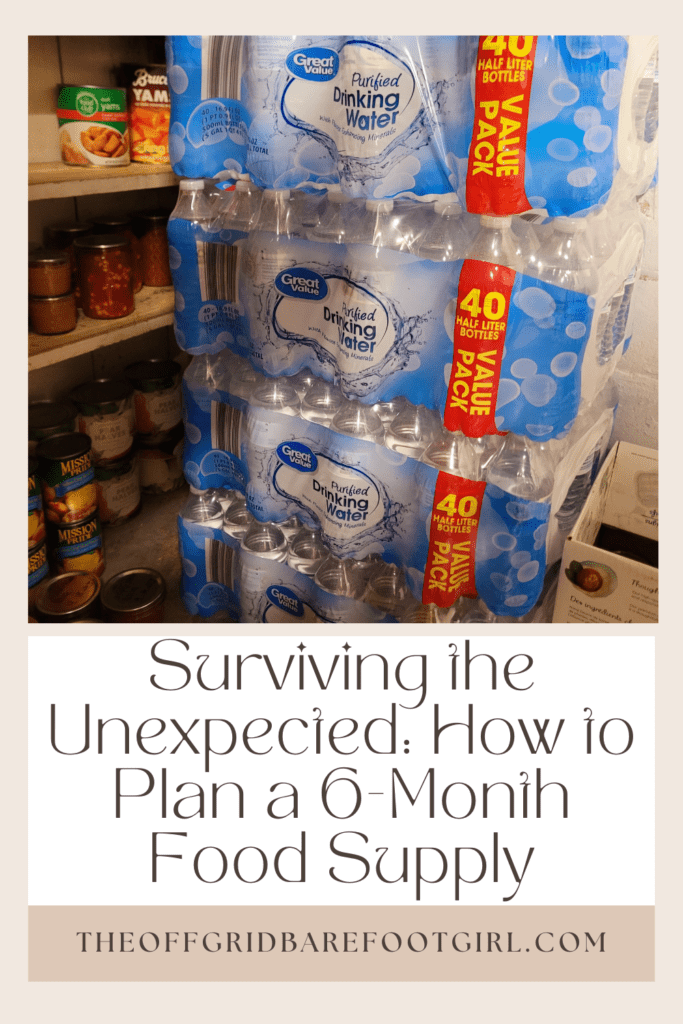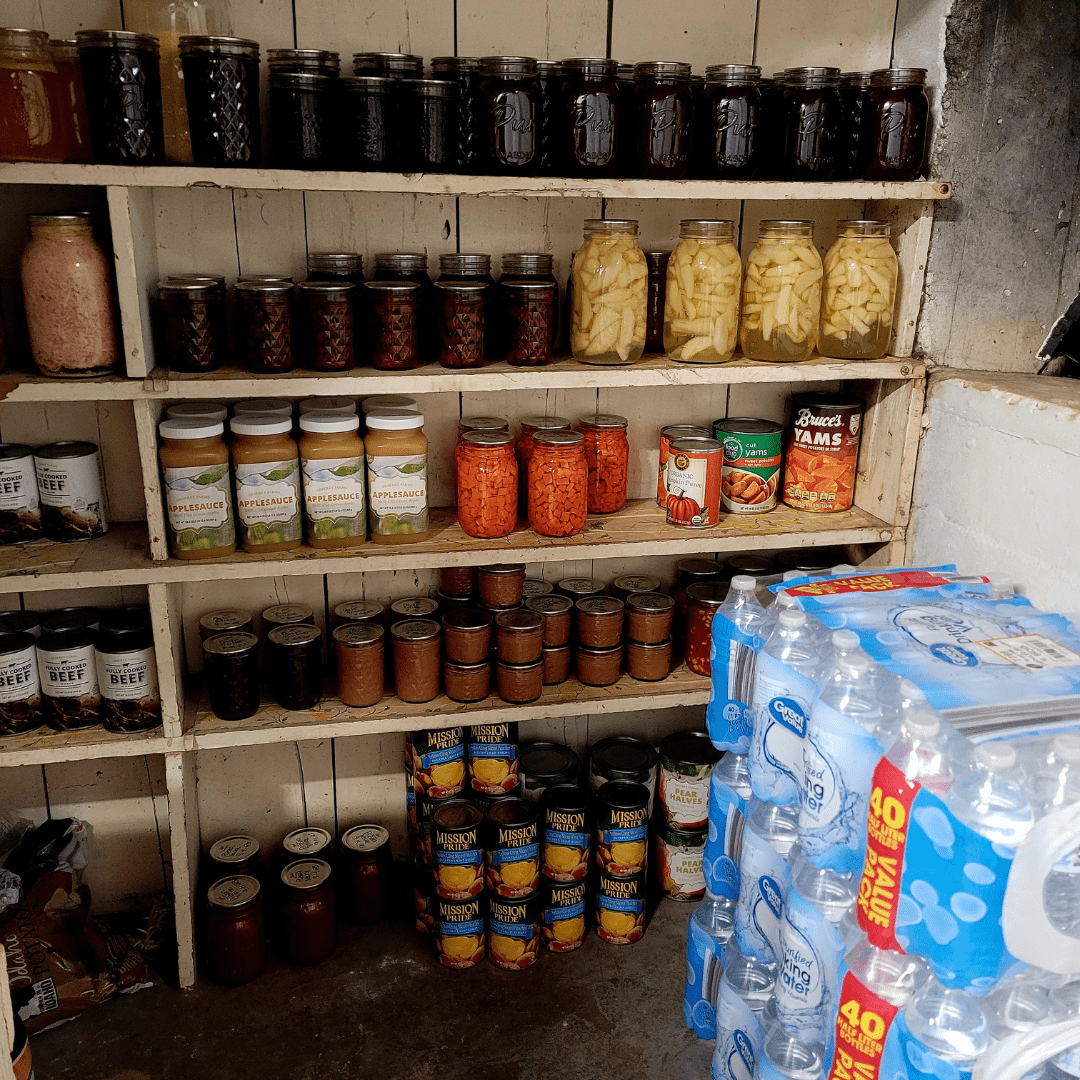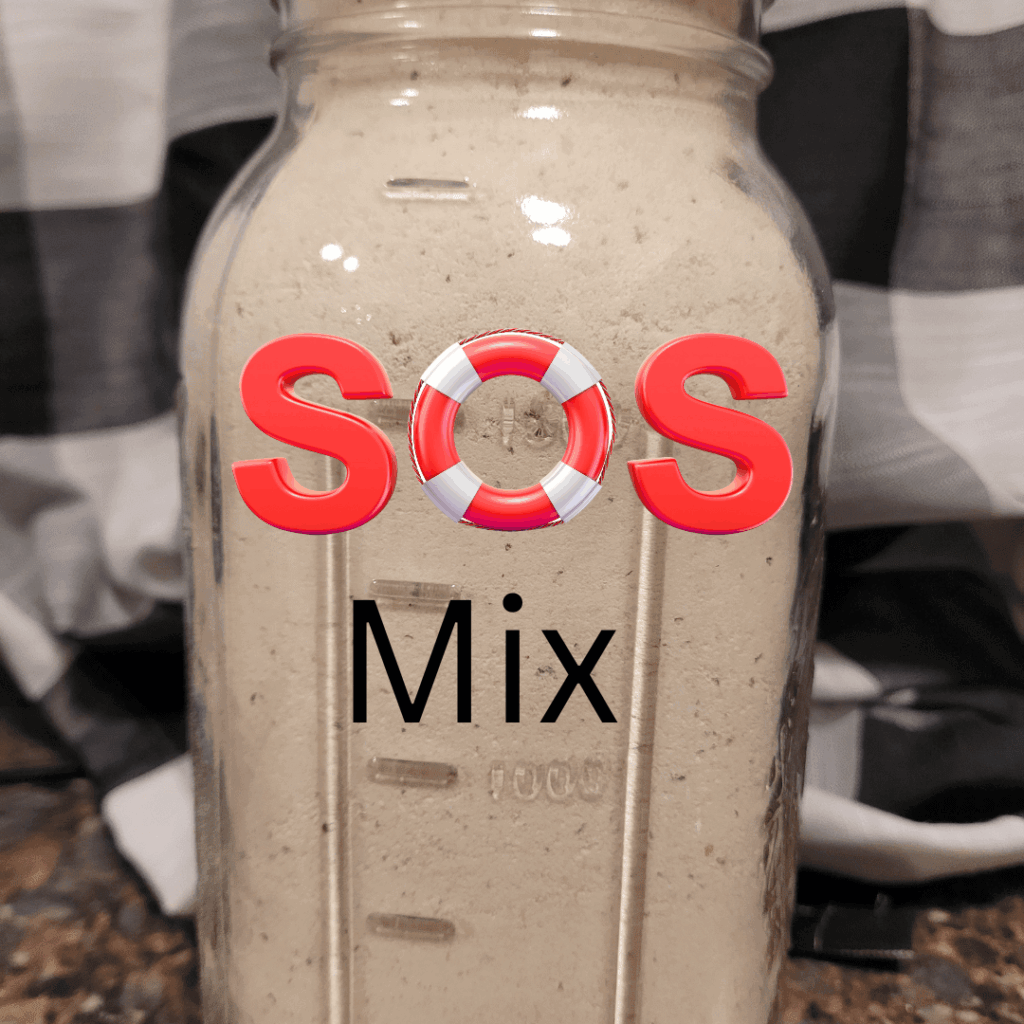Build a reliable 6-month food supply with simple, practical steps. I’ll show you exactly how I stock, store, and rotate food so you can thrive through the unexpected.
I’ve learned that the unexpected doesn’t always announce itself—storms roll in, jobs vanish overnight, shelves go empty, and life just… shifts. That’s why I started building a 6-month food supply, not out of fear, but out of a deep desire to keep my family steady no matter what comes. In this guide, I’m walking you through exactly how I plan, store, and rotate our food stash here on my own homestead. Nothing fancy, nothing overwhelming—just real systems that have kept us fed, calm, and confident through more than one wild season.
This is a pinnable post. Tap or hover over any image in this post to pin to your Pinterest Boards.

Importance of a 6 Month Food Supply
Understanding the Need for Long-Term Food Storage
Picture this: a zombie apocalypse, a natural disaster, or even a global pandemic. While these scenarios may seem like stuff from movies or TV shows, the truth is that unexpected emergencies or disruptions can happen. That’s where a 6 month food supply comes in handy.
When faced with an unexpected crisis or prolonged period of uncertainty, having a reliable and well-stocked food supply can be a game-changer. It ensures you and your loved ones have access to nourishment when grocery store shelves are bare or supply chains are disrupted. It ensures you won’t have to scramble for food when store shelves are empty or when access to grocery stores is limited. Plus, it saves you from resorting to odd combinations of canned foods and instant noodles that are doomed to become monotonous after a while.
Benefits of Having a 6 Month Food Supply
Having a 6 month food supply offers several benefits beyond just emergency preparedness. Firstly, it provides peace of mind. Knowing that you have a stash of food to rely on in times of need can alleviate stress and worry. It also saves you from the inconvenience of constantly worrying about grocery shopping or scrambling for supplies during a crisis.
Additionally, having a stockpile of food allows you to maintain a sense of normalcy in your daily routine, even when everything else seems chaotic. It gives you the freedom to focus on other essential tasks and provides a safety net for unexpected events.
Evaluating Potential Scenarios and Risks
While it’s impossible to predict every element of a crisis, it’s still valuable to evaluate potential scenarios and risks that might leave you without access to regular food sources. Consider events like extreme weather conditions, power outages, economic emergencies, or disruptions in the food supply chain.
By understanding the potential risks, you can assess the level of preparedness required for your situation. While a 6 month food supply may seem excessive to some, it may be necessary for those living in remote areas, areas prone to natural disasters, or for individuals with specific health needs.
Assessing Your Dietary Needs and Preferences
Evaluating Nutritional Requirements
Before planning out your 6 month food supply lists, it’s crucial to consider your unique dietary needs. Assessing your nutritional requirements will help ensure that you have a well-rounded assortment of foods that can sustain you in the long run.
Take into account factors such as age, gender, activity level, and any underlying health conditions. Consider including a balance of macronutrients (carbohydrates, proteins, and fats), as well as vitamins and minerals essential for overall health.
Considering Dietary Restrictions and Preferences
When planning your food supply, don’t forget to take into account any dietary restrictions or food preferences. Whether it’s specific allergies, religious dietary guidelines, or personal preferences, make sure your stockpile accommodates these needs.
Including a variety of options, such as gluten-free, vegetarian, or vegan products, can ensure that everyone in your household can find suitable sustenance in any given circumstance.
We all have our specific dietary needs and preferences. Whether it’s gluten-free, vegetarian, or a peanut allergy, it’s crucial to consider these factors when planning your food supply. Ensuring that everyone’s dietary restrictions and preferences are accommodated will prevent unnecessary stress and discomfort during any crisis.
I have a son who is lactose intolerant, and I need to ensure the pantry is fully stocked to accommodate his dietary needs without him stressing too much about what he can consume during an emergency. This ensures everyone will have peace of mind knowing they will be able to safely eat the food in the pantry when the grocery store shelves are bare.
Building a Comprehensive Shopping List
Identifying Essential Food Staples
Building a comprehensive shopping list is the key to creating a well-rounded 6 month food supply. Start by identifying essential food staples that have a long shelf life and provide substantial nutrition. These could include items like grains, beans, canned fruits and vegetables, sauces, and condiments.
Don’t forget to include sources of protein like canned fish, jerky, or plant-based alternatives if you’re vegetarian or vegan. And of course, don’t neglect your sweet tooth – having a stash of comfort foods or treats can help boost morale during challenging times.
If you need help determining which foods you should be stockpiling, I have written many posts with other helpful topics that are packed full of information on pantry items that will last forever in your pantry. You can be sure to stockpile large quantities of these shelf-stable foods to ensure the longevity of your survival pantry. Check out the comprehensive list of pantry items to start stockpiling now in these helpful posts!
Prep Your Pantry
- Survival Foods That Will Last Forever in Your Pantry
- Practical Pantry Prepper: Essential Guide
- SHTF Prepper’s Pantry List: Apocalypse-Proof Your Food Supply Now!
- How to Grocery Shop Once a Month
- Thirsty for Survival: Expert Guide to Emergency Water Prep Tactics
- Surprising Ways to Use Powdered Milk in Your Recipes
- Best Foods to Stockpile for Survival Now: Prep Your Pantry
Balancing Shelf-Stable Foods with Fresh and Frozen Options
While shelf-stable foods are the backbone of a long-term food supply, it’s also crucial to include fresh and frozen options whenever possible. This helps maintain a balanced diet and adds variety to meals, making them more enjoyable. Consider freeze-dried or dehydrated fruits and vegetables that retain their nutritional value and flavor for a long time.
Calculating Quantities for a 6 Month Supply
Before diving into your shopping list, it’s essential to determine how many people you’ll be stocking up for. Whether it’s just you or your entire family, the number of people will directly impact the quantity of food you should consider.
Estimating the right quantities for a 6 month food supply can be a bit of a challenge. Consider your household size, the number of meals you typically consume in a day, and the calorie requirements for each individual. A good rule of thumb is to aim for approximately 2,000 calories per person per day.
To calculate quantities, multiply the number of people by the number of days in 6 months, and then determine the required quantities of each food item accordingly, and by how often you and everyone eat in a day. It’s always better to have a little extra, just in case.
Storing Food for Long-Term Survival
Choosing Appropriate Storage Containers
Storing your food properly is crucial to maintaining its quality and longevity. When it comes to long-term food storage, opt for containers that are airtight, moisture-resistant, and made from food-grade materials. Mason jars, food-grade plastic buckets with tight-fitting lids, or mylar bags with oxygen absorbers are popular choices.
Avoid using containers that can leach harmful chemicals into your food, such as old soda bottles or non-food-grade plastic bags. Investing in quality storage containers will ensure your food stays fresh and safe for an extended period.
Implementing Proper Storage Techniques
Proper storage techniques are essential to maximize the shelf life of your food. Keep your food supply in a cool, dry place, away from direct sunlight, extreme temperatures, and pests. Place labels on containers with the expiration dates and rotate your stock, using the oldest items first.
Regularly inspect and check for signs of spoilage, such as bloating, foul odors, or unusual discoloration. It’s also a good idea to keep a record of your stockpile, noting the quantity and expiration dates, so you can easily manage and replenish your supplies.
Meal Planning and Rotation Strategies
Creative Meal Planning with Stored Foods
When it comes to meal planning with your stored foods, get creative! Don’t limit yourself to basic meals. Think outside the can and experiment with different combinations. Take that can of beans and turn it into a delicious chili or mash it up for a tasty bean dip. Get adventurous and try new recipes using the ingredients you have on hand. You might just discover a new family favorite!
Rotating Food Inventory to Maintain Freshness
To ensure the freshness of your stored food, it’s essential to practice rotation. Rotate your inventory by using the oldest items first and replacing them with new ones. This way, you’ll avoid having food go bad before you get a chance to use it. Keep a close eye on expiration dates and make a habit of checking your inventory regularly. It’s better to be safe than sorry when it comes to your food supply.
Nobody likes discovering a dusty can of beans from 1999 hidden in the back of the pantry. Use the “first in, first out” method, which means you should consume the oldest items first and replace them with new ones at the back of the storage area. This way, you’ll maintain the freshness and quality of your supplies and won’t find yourself stuck with expired or spoiled food when you need it most.
Ensuring Proper Nutrition and Variety
Incorporating a Balanced Diet in Your Food Supply
While it’s tempting to stock up on comfort foods and your personal favorites, it’s essential to include a variety of nutritious options in your food supply. Aim for a balanced diet that includes a mix of proteins, carbohydrates, fruits, and vegetables.
Canned fruits and vegetables can provide essential vitamins and minerals, while canned meats and legumes can be great protein sources. Don’t forget to include whole grains, like rice or oats, for added nutrition. Aim for items that can be stored for an extended period without refrigeration.
Introducing Variety Through Spices and Condiments
Spice up your food supply by stocking up on a variety of spices and condiments. These small additions can make a big difference in flavor and help break the monotony of your meals. From salt and pepper to hot sauce and herbs, there’s no limit to the ways you can enhance the taste of your stored foods. Plus, condiments like ketchup, mustard, and mayonnaise can add a familiar touch to your dishes and boost morale during challenging times.
Managing Inventory and Tracking Expiration Dates
Organizing and Tracking Food Inventory
To effectively manage your food supply, organization is critical. Keep your stored foods in a designated area that’s cool, dry, and away from direct sunlight. Use clear containers or labels to ensure easy visibility and access to your inventory.
Additionally, creating an inventory list, either on paper or digitally, can help you keep track of what you have and when items need to be used or replaced. Stay organized, and you’ll always know what’s in your pantry.
Understanding Expiration Dates and Food Safety
Expiration dates can be confusing, but understanding them is crucial for food safety. Familiarize yourself with the differences between “best by,” “use by,” and “sell by” dates. While these dates indicate when a product is at its peak quality, it doesn’t necessarily mean it’s unsafe to consume afterward.
Trust your senses and use your judgment. If the food looks or smells off, it’s better to err on the side of caution and dispose of it. Remember, safety always comes first.
Tips for Budgeting and Cost-Effective Meal Preparations
Smart Shopping Strategies for Long-Term Food Supply
When shopping for your long-term food supply, be a savvy shopper. Look for sales, buy in bulk, and compare prices. Consider purchasing generic or store brands, as they can often be just as good as the more expensive options.
Don’t forget to take advantage of coupons and loyalty programs to stretch your budget even further. Planning ahead and making smart choices can help you build your food supply without breaking the bank.
Here are some of my tips for helping you save money when shopping for your 6-month food supply.
10 Ways to Save Money on Groceries During Inflation
Utilizing Leftovers and Minimizing Waste
Minimizing waste is not only good for the environment, but also for your budget. Get creative with leftovers and find ways to incorporate them into new meals. Leftover chicken can be transformed into a delicious stir-fry, and yesterday’s roasted vegetables can be added to a hearty soup.
Embrace your inner chef and think of leftovers as opportunities rather than burdens. By using every last bit, you’ll make the most out of your food supply and save money in the long run.
Preparing for the Unexpected: Tips for Handling Emergencies
Developing a Plan for Power Outages
Emergencies can strike at any time, and power outages are common. Make sure you have a plan in place for such scenarios. Consider investing in a generator or alternative power sources to keep your food supply from spoiling during extended power outages.
Also, have a stash of non-perishable and easy-to-prepare foods that don’t require cooking, in case your kitchen temporarily turns into a culinary ghost town.
For such instances, I have tips on why you should be stockpiling MRE meals for survival in your pantry.
Stockpiling MRE Meals for Survival: Prep Your Pantry
Stocking Non-Food Necessities for Emergency Situations
Food is essential, but there are other necessities you’ll need to survive unforeseen circumstances. Stock up on non-food items such as water, batteries, flashlights, first aid supplies, and personal hygiene products.
Having these essentials readily available can provide comfort and support during challenging times. Plus, you’ll be the family hero when everyone else is frantically searching for a working flashlight!
For more tips on what to stockpile for emergencies, check out my other informative posts.
- What Should Be in A 72-Hour Survival Kit?
- Buy or Die: Prepper Items You Need Now
- Are Survival Food Kits Worth It? The Truth Revealed!
- Why Stockpiling Survival Books Before SHTF Can Save Your Life!
- Get Lockdown Ready: Best Dollar Tree Survival Items
- What Do Doomsday Preppers Stock? Prep Like a Prepper Now
Adapting Recipes to Fit Long-Term Storage Ingredients
When cooking with your long-term storage ingredients, it may require some adjustments to your go-to recipes. Consider the shelf-stability and cooking times of the ingredients you have available. Opt for recipes that can be easily modified and don’t rely heavily on perishable items. Embrace the challenge of cooking with limited resources, and you might just discover a hidden talent for recipe improvisation.
Conclusion
In conclusion, by planning and preparing a 6 month food supply, you are taking a proactive step towards ensuring the well-being and security of yourself and your family. Remember to regularly assess and rotate your food inventory, staying mindful of expiration dates and nutritional needs. With careful planning, organization, and a focus on budget-conscious strategies, you can confidently face unexpected circumstances, knowing that you have a reliable source of sustenance. By implementing the tips and techniques outlined in this article, you can navigate through challenging times with resilience and peace of mind.
Remember, planning a 6 month food supply does not mean you have to live in constant fear or paranoia. It’s simply a smart and practical way to ensure your well-being and that of your loved ones, no matter what unexpected events may come your way. Stay prepared, stay safe, and keep those taste buds ready for anything!
Above all, remember that life is unpredictable, and no matter how well you plan, unexpected situations can still arise. Stay flexible and adaptable in challenging circumstances. If you find yourself faced with a situation that requires adjusting your food supply plan or rationing your resources, embrace the challenge.
By taking the time to plan and create a 6 month food supply, you are proactively safeguarding yourself and your loved ones against unexpected circumstances. Remember to regularly rotate and manage your food stockpile, ensuring freshness and quality. Additionally, stay informed about expiration dates and regularly update your inventory. With a diverse and nutritious food supply, you can have peace of mind knowing that you are prepared for whatever challenges may come your way. Start planning today and build your resilience for a brighter tomorrow!
Resources: Here are some more resources for you to check out!
- 6-Month Emergency Food Supply – By Ready Hour
- 6-Month Food Kits – By PrepSOS
- What to Stock for Emergencies – By Unite to Light

Frequently Asked Questions
1. How much food should I store for a 6 month supply?
Calculating the required food quantity for a 6 month supply depends on factors such as the number of people to feed and their daily caloric intake. It is recommended to estimate the daily caloric needs of each individual and multiply it by the number of days in 6 months, taking into account any dietary restrictions or preferences.
2. How do I ensure the freshness of my food stockpile?
To maintain the freshness of your food stockpile, implement a rotation system using the first-in, first-out (FIFO) method. Regularly monitor expiration dates and use older items first while adding fresh supplies to the back of the storage area. This practice ensures that your food remains fresh and minimizes waste.
3. Can I include fresh or frozen foods in my long-term food supply?
While the majority of your food stockpile will consist of shelf-stable items, it is beneficial to include a balance of fresh and frozen foods as well. Foods such as fruits, vegetables, and meats can be preserved through freezing or canning, providing variety and valuable nutrients in your long-term food supply.
4. How often should I update my food inventory?
Regularly updating your food inventory is essential to ensure you have an accurate record of your supplies. It is recommended to review and update your inventory at least every three months. This allows you to identify any expired items, make note of things that need to be restocked, and adjust your meal plans accordingly.
Summary
I hope I have inspired you to stockpile your pantry for your survival needs.
If you were encouraged by this post, I invite you to check out my FREE Printables Page for fun free printables, planners, and charts.
ENTER MY FREE Printables Page HERE
Here are some more of my canning inspiration posts to check out!
Pears: How to Make and Can Pear Honey
Pears: How to Make and Can Salted Caramel Pear Butter
Butternut Squash: How to Make and Can Butternut Squash Butte
Quince: How to Make and Can Fall Spiced Quince Chutney
Quince: How to Can Quince
Carrot Cake Butter: How to Make and Can Carrot Cake Butter
Peach Pie Filling: How to Make and Can Peach Pie Filling
Pear Pie Filling: How to Make and Can Pear Pie Filling
The Best Winter Pantry Staples to Stockpile Now!
More Recipes!
Grapes: How to Make and Can Grape Jam
Apple Cider: How to Make Homemade Apple Cider Vinegar
How to Make and Can Cherry Plum Jam
How to Make and Can Apple Butter In Crockpot
Stockpiling Condiments for Survival: Learn How I Do It!
How to Make and Can Vegetable Pot Pie Filling
Easy Canning Applesauce Recipes to Stalk Your Pantry!
How to Make Peach Jalapeno Jam
Cherries: How to Make Cherry Pie Filling
Cherries: How to Make Cherry Syrup
Salsa: How to Make and Can Cherry Salsa
Peaches: How to Make and Can Peach Salsa
Canning Supplies You Need Now for a Successful Canning Season
How to Make and Can Balsamic Onion Jam
Cranberry Sauce: How to Make and Can Old Fashioned Cranberry Sauce
How to Make and Can Cranberry Merry Jam
How to Make and Can Strawberry Shortcake Jam
Cherry Jam: How to Make and Can Cherry Pie Jam
Carrot Cake Jam: How to Make and Can Carrot Cake Jam
Quince Jam: How to Can a Year’s Supply of Quince Jam
Root Beer Float Jelly: How to Make and Can Root Beer Float Jelly
Blessings,
The Off Grid Barefoot Girl





